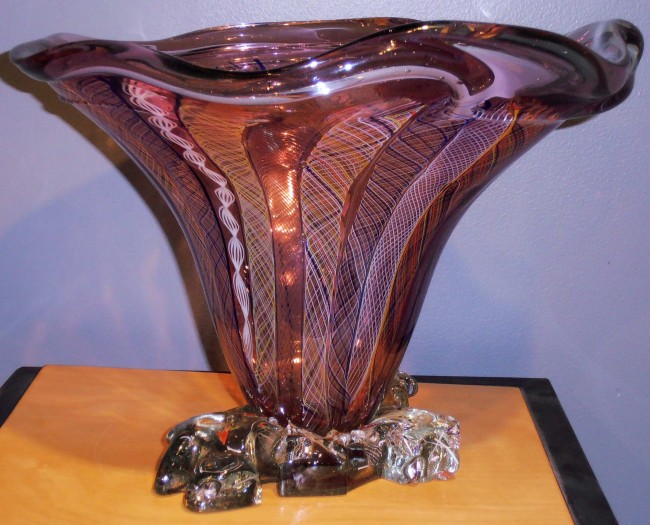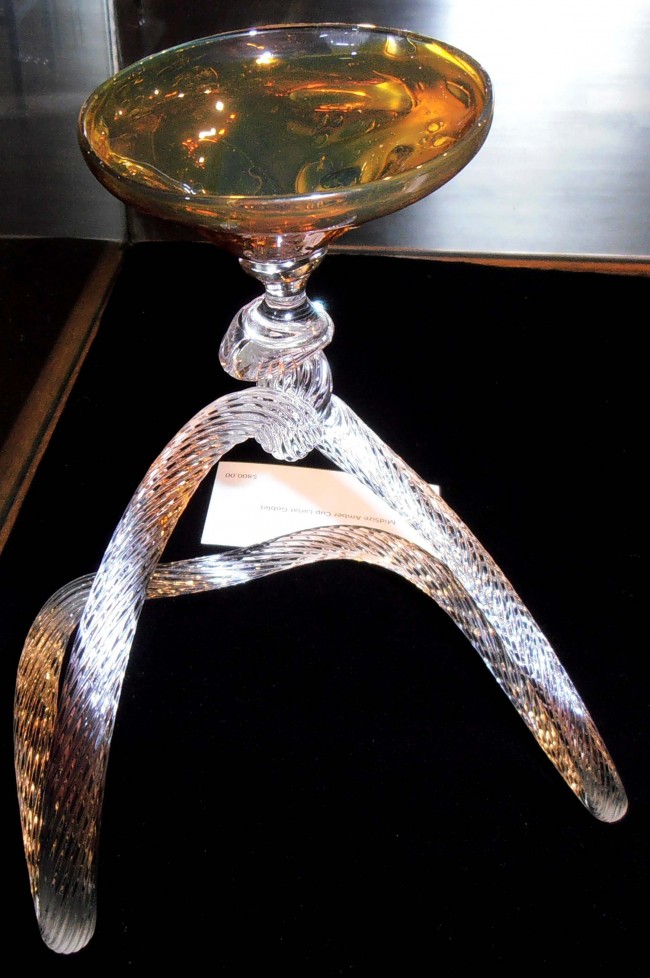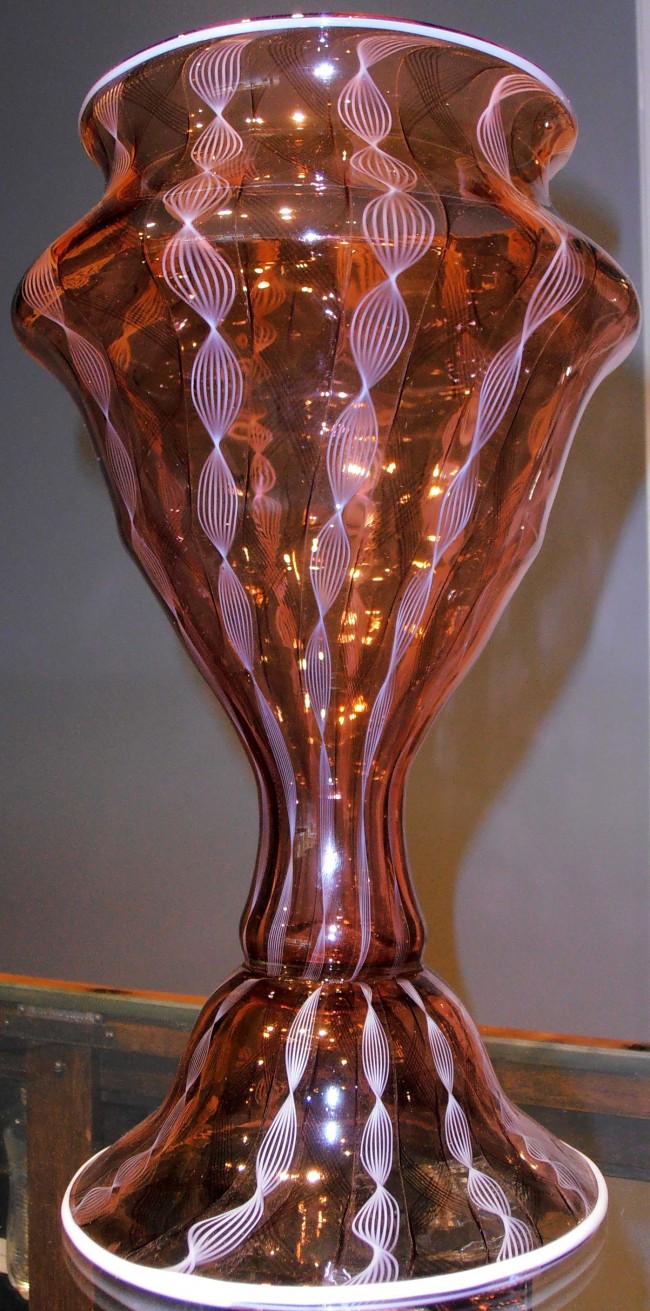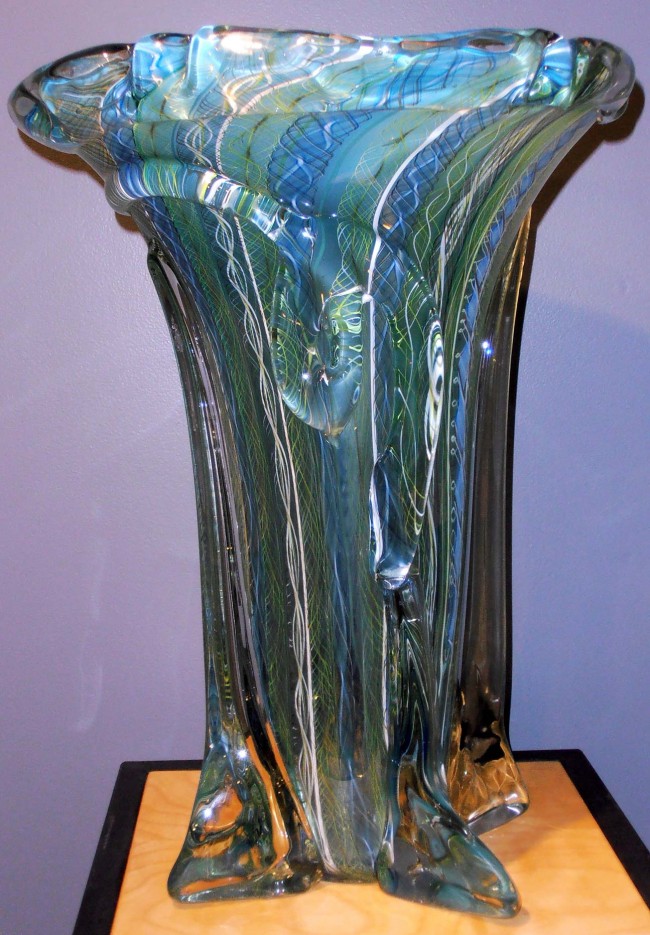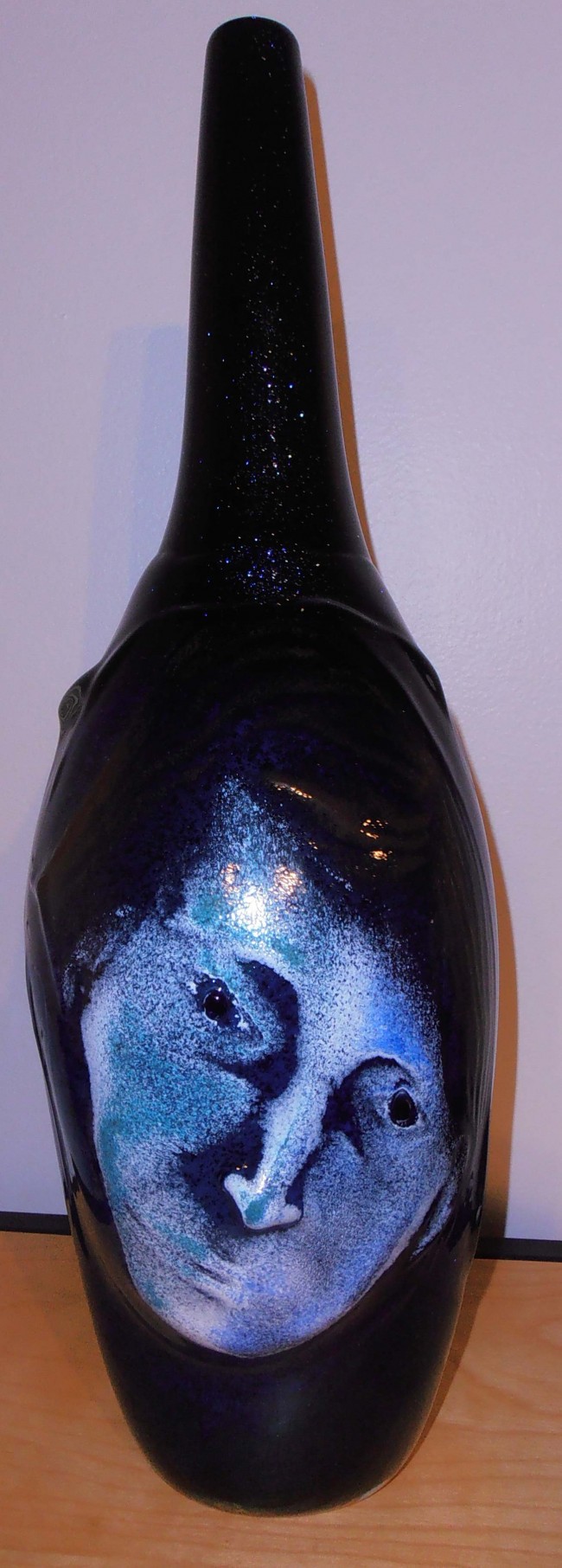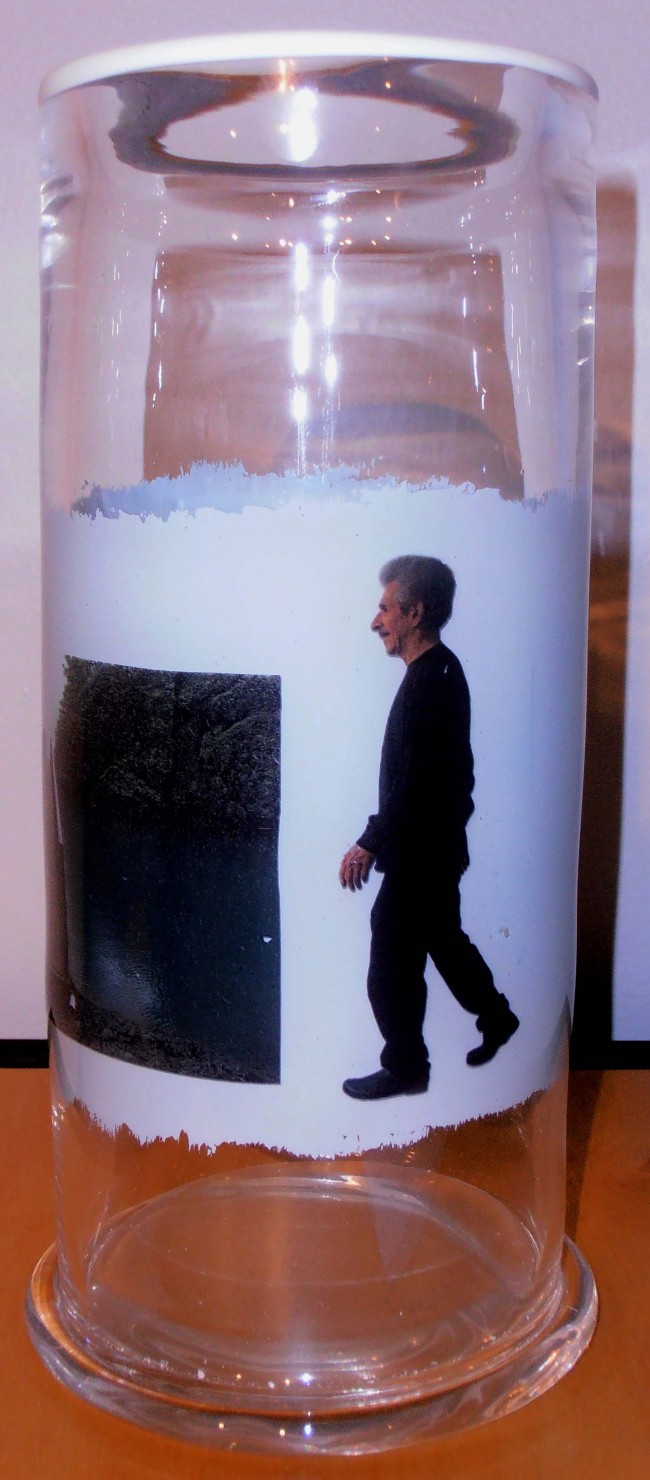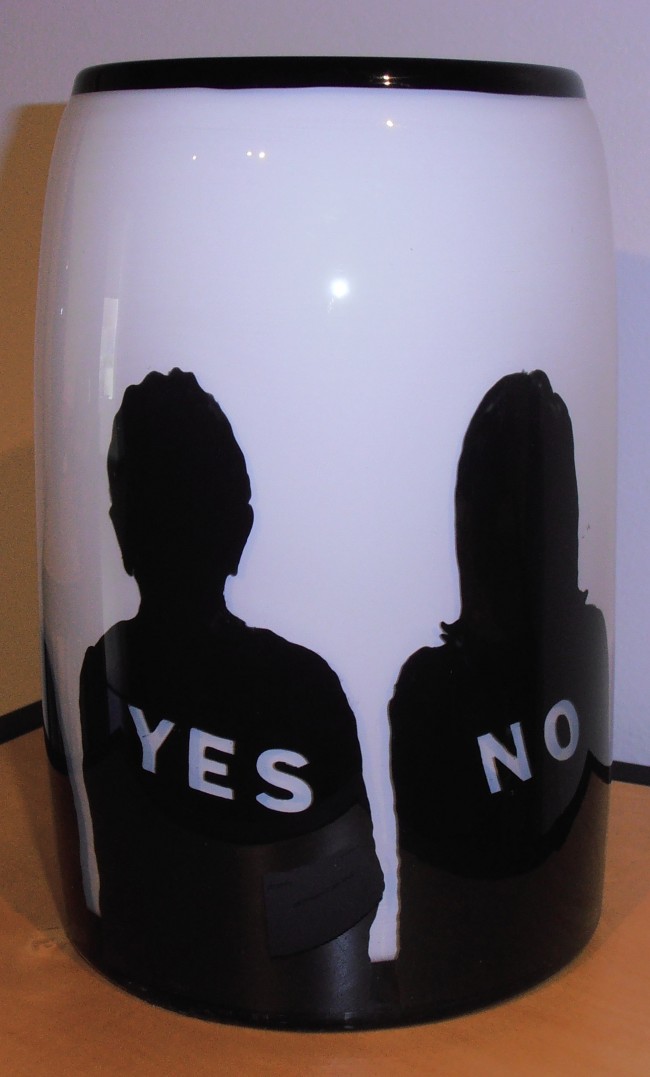The Neusole Glassworks has moved from Walnut Hills to Forest Park, from a neighborhood where police crime scene tape and chalk outlines are common to a verdant college-campus-like industrial park. The building, which houses facilities for glassblowing, glass fusing, and lampworking, is smaller than the East McMillan location, but feels much larger with the open workspace for classes and public-access rental, commodious gallery (Atmosphere@neusole), and gift shop. There’s also a banquet space that can be rented for special events, which might include demonstrations of glass techniques or even opportunities for guests to try their hands working with the challenging medium.
To celebrate the nonprofit’s opening, Neusole invited studio glass pioneers Fritz Dreisbach and Paul Marioni as artists in residence for a week. The gallery kicked off its schedule with “Two Buckeyes,” featuring a representative selection of their works plus pieces done during the residency.
Ohio has played a seminal role in the birth of what’s become known as the Studio Glass Movement. In fact, you can say it was born here in 1962 when Harvey Littleton (1922-2013), a potter and the son (his father developed Pyrex) and grandson of scientists at Corning Glass Works, organized two workshops at the Toledo Museum of Glass. The purpose was to demonstrate that glass could be blown outside the factory setting where hundreds of pounds glass are melted and teams of glassblowers produce functional and decorative glass objects, sometimes numbering in the thousands. Littleton wanted to prove that glass could be melted in small furnaces, and that an artist did not need a team of workers. He wanted artists to express their own aesthetic and work directly with the material rather than being a designer asking artisans to realize their visions.
Littleton is frequently called the father of studio glass, but he needs to share that sobriquet with Dominick Labino (1910-1987). A research scientist employed by Johns-Manville Fiber Glass in Toledo, he held 60 patents and was instrumental in developing insulation for the Apollo and Gemini spacecraft. For this first workshop, he provided steel and a burner for a rather primitive furnace, and, most importantly, his #475 glass marbles, which melted at relatively low temperatures to produce workable glass for the attendees.
Although Labino shared his technical knowledge with other budding glass artists and set up the glass program at Bowling Green University, Littleton was the untiring evangelist for glass as an artistic medium. In his classes at the University of Wisconsin, Madison, he taught essentially all of the first generation Studio Glass artists, who then established glass departments at colleges and universities across the country.
Born in 1941 in Cleveland, Dreisbach studied with Littleton, receiving his M. F. A. from the University of Wisconsin in 1967. He was nicknamed the Johnny Appleseed of glass because of his extensive travels to give lectures, demonstrations, and workshops and his teaching appointments; the listing of them takes more than four single-spaced pages on his résumé.
Dreisbach has pursued several series concurrently, and each is identified on his website (fritzdreisbach.com)– Goblets, Big, Playful, Carved Glass, and Lariats. And they’re all represented in this exhibition. Perhaps the one thing that ties all of this work together is his irreverent use of traditional techniques including Venetian style blown glass, carving, engraving, flameworking, and hot working.
For example, he uses Venetian filigrana or filigree glass where colored, very often white, rods of glass are picked up on a molten bubble of glass and “gathered over” — encased — in clear glass. A second steel rod is attached to the bottom of the bubble, which is still on the blowpipe, and two glassworkers walk away from each other, pulling the molten glass like taffy, sometimes twisting it to make intertwining threads of glass for a lacy effect — think candy canes. Cooled and cut into rods, they are used to decorate the surface of glass objects as they are “picked up” on a hot bubble of glass, melted into it, and then covered with another layer of clear glass.
Included in the Big category are the artist’s Mongos: thick, misshapen, and muscular vessels. They are the antithesis of the Venetian style, which is delicate, symmetrical, and ethereal. In the Mongos filigrana canes become distorted in the blowing process as Dresibach manipulates the form, pulling it out of shape in contrast to the symmetry naturally produced by the glassblowing process as the bubble or paraison is rotated on the blowpipe.
Dreisbach’s footed Goblets display his wit as he riffs on traditional dragon-stem goblets made during Venice’s heyday in the 16th century. As their name implies, their stems are fanciful, flame-worked creatures that support delicate cups. Dreisbach perverts that form in delightful, freeform ways. I particularly liked his Killer Harlequin Reversible Champagne/Cognac, which was made at Neusole. The cup stands on a brandy snifter shape with a ribbed body created by thrusting the bubble of glass into an optic mold and blowing until it becomes the positive to the mold’s negative. The champagne half of the multi-purpose glass is flared. Connecting them is a stem decorated with a few clear rods of glass that are pulled and looped to make a tangible drawing in space. Dreisbach uses the same techniques as a Venetian master would have to make his goblet, but with very different results.
Paul Marioni is a hometown boy. Born in Cincinnati in 1941, he received his B. A. in English and philosophy from the University of Cincinnati in 1967 and left Cincinnati five days after graduation. He has said, “I don’t know why it took me five days.”
Marioni’s part of the trio of Marioni brothers who all became artists: Joe, a monochrome painter in New York, and Tom, a conceptual artist in San Francisco. He’s also the father of glassblower Dante Marioni who’s mastered the Venetian techniques but often bumps up the scale of traditional forms or elongates them into the glass equivalent of Mannerism.
While I’d categorize Dreisbach’s art as decorative (never a pejorative in my mind), Marioni’s best work incorporates a message. One of my favorite works here is Lake Crescent, a cylinder with a self-portrait in profile walking toward a dock that juts out into the lake. On the other side of the pier is a nude Greco-Roman wrestler. Marioni is expressionless as he advances toward exactly what?
And then there’s The Something or Other Society, another cylinder, with five silhouetted figures (black on white) facing inward with the following words and punctuation marks “dropped out” on their individual backs: “Yes,” “No,” “!,” “Maybe,” and “?.”
Marioni’s a witty guy, too. Take Big Whistling Vase, for example. Lying on the pedestal is a large teardrop-shaped, bubblegum-pink vessel. It tapers to a narrow, appropriately pursed mouth outlined in bright red, which a glassblower would call, rather appropriately here, a “lip wrap.” That’s funny enough but catch the bottom, which is a quite delicious derrière.
Neusole had been looking for a new home for years, and even bought the reportedly haunted Windsor School. In making the decision to move northward, Bradley, executive director, says Neusole looked at whom the school and public access glass facility was serving and found 78% came from north of Reading.
Neusole was founded in 2004 by John Schiff. It wasn’t the first glass facility the businessman/philanthropist/glass artist had been associated with. In 1988 he became a trustee of Golden Glass Studio and School on the west side. His next endeavor was to co-found River City Glass in Over-the-Rhine in 1992. In 1996 he gave the studio to the Art Academy, which, due to lack of funding, closed in July 2009. Schiff named the new glass studio Neusole after surviving a lightning strike. He felt he was a new soul after that experience.
Now Neusole Glassworks has been re-born with its move to Forest Park.
–Karen S. Chambers
“Two Buckeyes: Fritz Dreisbach and Paul Marioni,” Atmosphere@neusole, closed. Neusole Glassworks, 11925 Kemper Springs, Forest Park, OH 45240. 513-751-3292, neusoleglassworks@hotmail.com, www.neusoleglassworks.com.

